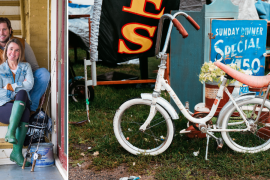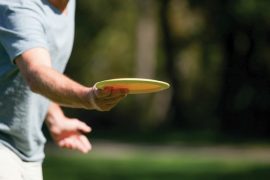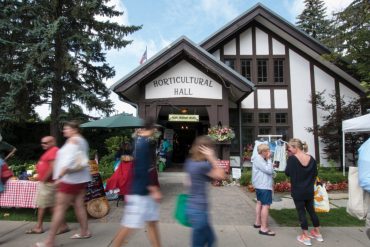By Rhonda Mix | Photography by Holly Leitner
Fancy a bit of rainbow trout fishing but not sure where to go to hook the best catch?
Located right in our own backyard, nestled in the southern tip of the beautiful Kettle Moraine State Forest near Palmyra, is the largest rainbow trout farm in Wisconsin: Rushing Waters Fisheries. This 80-acre woodland is an ideal place to throw in a line, kick back with family or friends and enjoy an afternoon of fishing any time of year.
Although the state ranks first in the Midwest for aquaculture and is home to more than 2,400 fish farms, Rushing Waters’ 56 artesian spring-fed ponds are home to some of the highest quality rainbow trout on the market, according to co-owner, Peter Fritsch. “It is our niche,” he says. “Our motto is ‘when quality matters.’”
The very cold, 50-degree water temperature creates an ideal climate in which the fish can thrive. Ponds provide grass borders, weeds and natural, sandy bottoms. The habitat mimics the species’ native environment and contains a diverse ecosystem that gives the fish access to food sources they would typically find in the wild, without chemical interference. Trout are also fed a special diet of soy-based fish food pellets. Aerators help to keep the pond water on the move and spreading oxygen.
Rushing Waters’ rainbow trout are harvested by hand, year-round when they reach 1 to 1 ½ pounds. Their life span is longer than some other farmed fish — approximately 18 months from hatchery to harvest giving the trout plenty of time to grow into high-quality specimens.
After harvesting, Rushing Waters’ on-site processing plant readies the fish for distribution to grocers, specialty stores and restaurants throughout Wisconsin and Chicago, including Whole Foods, Outpost Natural Foods, Milwaukee’s St. Paul Seafood Market and Roundy’s Supermarkets.
Though the farm aims to produce 30,000 pounds of trout a month, Fritsch says Rushing Waters Fisheries prides itself on quality, not quantity. “That is what we go by,” he says. “It is not about how much or how fast we can produce fish. It is about giving the fish more room, water and husbandry without added chemicals. There are no hormones used here and our fish are given the best diet on the market, which is a home recipe I helped create. They may not be cheaper than some other rainbow trout out there, but it is because they are the best.”
FROM FOX FURS TO FISHERY
The history of Rushing Waters Fisheries dates to the early 1940s. The land the fishery sits on was originally the site of a fox farm, owned by a man named Steve Johnston. Johnston raised trout in the ponds on the property for hobby and as supplemental fox feed. Fox furs from the farm were sold at Navy Pier in Chicago.
According to Fritsch, fur prices collapsed after the onset of World War II and the market for fur began to dwindle dramatically. In order to keep his business going, Johnston switched gears and decided to focus instead on bringing fresh fish to Navy Pier. Fritsch says people loved the idea – especially because the fish came from neighboring Wisconsin, and its purveyor was considered a local food source.
In 1994, the former fox farm was purchased by Bill Graham, a businessman from the Madison area. Fritsch says it became Graham’s vision to change the farm into a special and unique fishery, and he soon began putting into motion practices which would help create a business of healthier, sustainable rainbow trout.
Fritsch, also a Wisconsin native, started working at the fishery in 1997 when he was just out of college. He says he did “every job at the farm,” starting out at the very bottom of the business and working his way up. Eventually, he became partner to Graham, and he now manages the day-to-day operations at the farm.
Trout inhabiting the fishing pond can grow much larger than Rushing Waters’ typical 1-pound harvest weight. According to a farm employee, rumor has it there is an 8-pound trout lurking in the pond. This year’s largest catch so far weighed in at 4.33 pounds and measured 24 inches long.
There is no limit on the amount of fish you can catch per day, but the farm’s fishing rules state that every fish caught must be kept, and fishermen pay by the pound for their catch. A new option called Hook & Cook lets visitors cast out a line and reel in their own lunch to be prepared on-site at Rushing Waters’ Trout House restaurant, which is a mere 100 yards away from the fishing pond. (Fish can also be cleaned and put on ice to keep fresh for the journey home.)
“A day at Rushing Waters is a great way to get back to nature and connect with the food circle,” Fritsch says. “It is a great way to get back to our roots, to the time when we were hunters and gatherers.”
DOESN’T GET ANY FRESHER
For years, the Rushing Waters retail store has been a wonderful source for fresh trout as well as frozen fish and seafood. Plus mouth-watering smoked trout is available due to the farm’s on-site smokehouse. With the opening of the Trout House restaurant in 2013, Rushing Waters now offers a wide range of menu options with food sourced from the fishery as well as farms throughout the region. The Trout House also offers a rotating seasonal menu and Fritsch says the Friday Night Fish Fry has become very popular with customers.
As a result of the Rushing Waters’ approach to all things fresh, it was recently showcased in an episode by the Emmy-nominated television program Wisconsin Foodie.
“I would say Rushing Waters features farm to fork dining at its best,” says marketing team member Sarah Wagner. “It is one of the truly unique gems in Wisconsin and in the Midwest. Nobody raises trout like we do in such a careful, natural manner, all the while focusing on quality and freshness.”
PROVING THE NAYSAYERS WRONG
Fritsch says that although he is appreciative of the fact people are gravitating toward eating locally and making healthier food choices, he believes there are often numerous negative stereotypes floating around in the media portraying false accusations about how dangerous farmed fish can be. He hopes to put an end to these stereotypes and false assumptions. While he admits there may be fish farms that do not adhere to the greatest standards, he encourages people to check out Rushing Waters for themselves — in person — if they are concerned or have questions.
“More people care now about where their food is coming from, and I’m glad people have questions,” he says. “I take my hat off to consumers for this curiosity. But the media tends to portray fish farms in a negative light. For whatever reason, someone decided to draw the line at fish and make farmed fish a much bigger deal [than other sources of meat out there]. But our passion shows in what we do,” he continues. “I encourage people to taste that passion and come out to the restaurant. All you have to do is get out here and come see us; these are free windows into our fish farm. We hope you can feel confident that you are making a good choice when visiting and learning what we are all about.”












